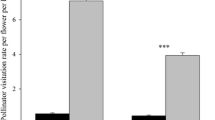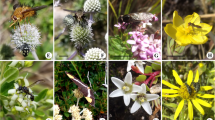Abstract
It has been proposed that in non-rewarding animal-pollinated plants the pollination intensity should decrease with increasing population size and should increase with increasing local abundance of reward-producing plants. To test these hypotheses, we examined how population size, local abundance of Salix caprea, and tree cover were related to pollen removal and fruit production in 16 populations of the deceptive, early-flowering and bumblebee-pollinated orchid Calypso bulbosa in northern Sweden in 3 consecutive years. To determine whether fruit production was limited by pollinator visitation, supplemental hand-pollinations were performed in three populations in 3 years. Finally, to examine whether increased fruit production was associated with a reduction in future flower production, vegetative growth or survival, supplemental hand-pollination was repeated for 5 years in one population. The levels of pollen export, pollen deposition, and fruit set of C. bulbosa varied considerably among years and among populations. The proportion of plants exporting pollen was negatively related to population size, and positively related to density of S. caprea and to tree cover in 1 of the 3 years. In the other 2 years, no significant relationship was detected between proportion of plants exporting pollen and the latter three variables. In no year was there a significant relationship between fruit set and population size, density of S. caprea and tree cover. There was substantial among-year variation in the extent to which fruit production was limited by insufficient pollen deposition and in the amount of weather-induced damage to flowers and developing fruits. Fruit set was consistently higher in hand-pollinated than in open-pollinated plants, but this difference was statistically significant in only one of 3 years. Supplemental hand-pollination in 5 consecutive years increased cumulative fruit production 1.8 times, but did not affect flower production, plant size, or survival. Tree cover was negatively correlated with the incidence of frost damage in 1 year. The results indicate that life-time seed production may be pollen limited in C. bulbosa, and that variation in population size and local abundance of the early-flowering, nectar-producing S. caprea can only partly explain the extensive variation in pollinator visitation among populations of this species.
Similar content being viewed by others
References
Ackerman JD (1981) Pollination biology of Calypso bulbosa var. occidentalis (Orchidaceae): a food-deception system. Madroño 3:101–110
Ackerman JD, Montalvo AM (1990) Short- and long-term limitations to fruit production in a tropical orchid. Ecology 71:263–272
Ågren J (1988) Between-year variation in flowering and fruit set in frost-prone and frost-sheltered populations of dioecious Rubus chamaemorus. Oecologia 76:175–183
Ågren J (1996) Population size, pollinator limitation and seed set in the self-incompatible herb Lythrum salicaria. Ecology, in press
Ågren J, Willson MF (1994) Cost of seed production in the perennial herbs Geranium maculatum and G. sylvaticum: an experimental field study. Oikos 70:35–42
Aizen MA, Feinsinger P (1994) Habitat fragmentation, native insect pollinators, and feral honey bees in Argentine “Chaco serrano”. Ecol Appl 4:378–392
Boyden TC (1982) The pollination biology of Calypso bulbosa var. americana (Orchidaceae): initial deception of bumblebee visitors. Oecologia 55:178–184
Calvo RN (1990) Four-year growth and reproduction of Cyclopogon cranichoides (Orchidaceae) in south Florida. Am J Bot 77:736–741
Calvo RN (1993) Evolutionary demography of orchids: intensity and frequency of pollination and the cost of fruiting. Ecology 74:1033–1042
Calvo RN, Horvitz CC (1990) Pollinator limitation, cost of reproduction, and fitness in plants: a transition-matrix demographic approach. Am Nat 136:499–516
Dafni A (1983) Pollination of Orchis caspia: a nectarless plant which deceives the pollinators of nectariferous species from other plant families. J Ecol 71:467–474
Ehrlén J, Eriksson O (1995) Pollen limitation and population growth in a herbaceous perennial legume. Ecology 76:652–656
Elmqvist T, Ågren J, Tunlid A (1988) Sexual dimorphism and between-year variation in flowering, fruit set and pollinator behaviour in a boreal willow. Oikos 53:58–66
Feinsinger P, Tiebout HM III, Young BE (1991) Do tropical birdpollinated plants exhibit density-dependent interactions? Field experiments. Ecology 72:1953–1963
Fritz A-L, Nilsson LA (1994) How pollinator-mediated mating varies with population size in plants. Oecologia 100:451–462
Gill DE (1989) Fruiting failure, pollinator inefficiency, and speciation in orchids. In: Otte D, Endler JA (eds) Speciation and its consequences. Sinauer, Sunderland, Massachusetts, pp 458–481
Heinrich B (1979) Bumblebee economics. Harvard University Press, Cambridge
Hultén E, Fries M (1986) Atlas of North European vascular plants north of the Tropic of Cancer. I–III. Koeltz, Königstein
Ingelög T, Andersson R, Tjernberg M (1993) Red data book of the Baltic Region, part 1. Lists of threatened vascular plants and vertebrates. Swedish Threatened Species Unit, Uppsala
Jennersten O (1988) Pollination in Dianthus deltoides (Caryophyllaceae): Effects of habitat fragmentation on visitation and seed set. Conserv Biol 2:359–366
Kunin WE (1993) Sex and the single mustard: population density and pollinator behavior effects on seed-set. Ecology 74:2145–2160
Lammi A, Kuitunen M (1995) Deceptive pollination of Dactylorhiza incarnata: an experimental test of the magnet species hypothesis. Oecologia 101:500–503
Lamont BB, Klinkhamer PGL, Witkowski ETF (1993) Population fragmentation may reduce fertility to zero in Banksia goodii — a demonstration of the Allee effect. Oecologia 94:446–450
Laverty TM (1992) Plant interactions for pollinator visits: a test of the magnet species effect. Oecologia 89:502–508
Laverty TM, Plowright RC (1988) Fruit and seed set in mayapple (Podophyllum peltatum): influence of intraspecific factors and local enhancement near Pedicularis canadensis. Can J Bot 66:173–178
Little RJ (1983) Floral food deception mimicries and floral mutualism. In: Jones CE, Little RJ (eds) Handbook of experimental pollination biology. Van Nostrand Reinhold, New York, pp 294–309
McCall CM, Primack RB (1992) Influence of flower characteristics, weather, time and day of season on insect visitation rates in three plant communities. Am J Bot 79:434–442
Montalvo AM, Ackerman JD (1987) Limitations to fruit production in Ionopsis utricularioides (Orchidaceae). Biotropica 19:24–31
Mosquin T (1970) The reproductive biology of Calypso bulbosa (Orchidaceae). Can Field Nat 84:291–296
Nilsson LA (1992) Orchid pollination biology. Trends Ecol Evol 7:255–259
Olesen JM, Jain SK (1994) Fragmented plant populations and their lost interactions. In: Loeschcke V, Tomiuk J, Jain SK (eds) Conservation genetics. Birkhäuser, Basel, pp 417–426
Primack RB, Hall P (1990) Cost of reproduction in the pink lady's slipper orchid: a four-year experimental study. Am Nat 136:638–656
Proctor HC, Harder LD (1994) Pollen load, capsule weight, and seed production in three orchid species. Can J Bot 72:249–255
Proctor HC, Harder LD (1995) Effect of pollination success on floral longevity in the orchid Calypso bulbosa (Orchidaceae). Am J Bot 82:1131–1136
Rathcke BJ, Jules ES (1993) Habitat fragmentation and plant-pollinator interactions. Curr Sci 65:273–277
Schemske DW, Willson MF, Melampy MN, Miller LJ, Verner L, Schemske KM, Best LB (1978) Flowering ecology of some spring woodland herbs. Ecology 59:351–366
Sih A, Baltus M-S (1987) Patch size, pollinator behaviour, and pollinator limitation in catnip. Ecology 68:1679–1690
Snow AA, Whigham DF (1989) Cost of flower and fruit production in Tipularia discolor (Orchidaceae). Ecology 70:1286–1293
Sowig P (1989) Effects of flowering plant's patch size on species composition of pollinator communities, foraging strategies, and resource partitioning in bumblebees (Hymenoptera: Apidae). Oecologia 78:550–558
Stoutamire WP (1971) Pollination in temperate American orchids In: Corrigan MJ (ed) Proceedings of the 6th world orchid conference. Halsted Press, Sydney, pp 233–243
Widén B (1993) Demographic and genetic effects on reproduction as related to population size in a rare, perennial herb, Senecio integrifolius (Asteraceae). Biol J Linn Soc 50:179–195
Wollin H (1975) On the biology of Calypso. (in Swedish) Fauna och Flora 70:89–98
Zimmerman JK, Aide TM (1989) Patterns of fruit production in a neotropical orchid: pollinator vs. resource limitation. Am J Bot 76:67–73
Author information
Authors and Affiliations
Rights and permissions
About this article
Cite this article
Alexandersson, R., Ågren, J. Population size, pollinator visitation and fruit production in the deceptive orchid Calypso bulbosa . Oecologia 107, 533–540 (1996). https://doi.org/10.1007/BF00333945
Received:
Accepted:
Issue Date:
DOI: https://doi.org/10.1007/BF00333945




